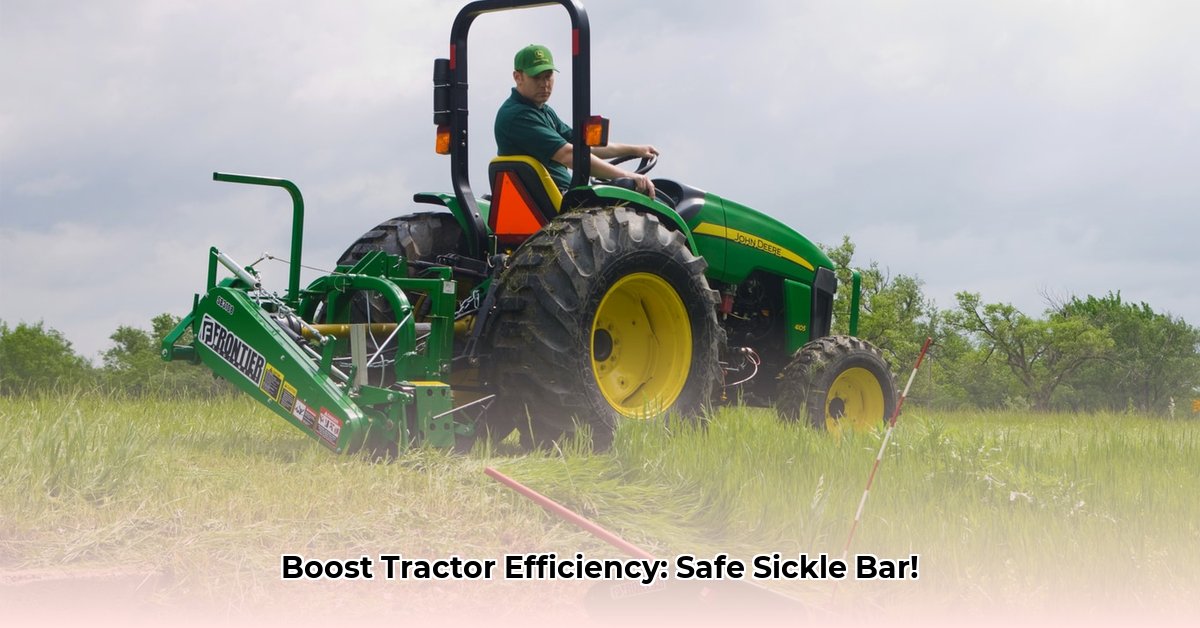
Tractor Sickle Bar: Boosting Efficiency and Ensuring Safety
A tractor sickle bar mower significantly enhances harvesting efficiency, especially for smaller fields. However, its powerful operation demands careful attention to safety protocols. This guide details safe and effective sickle bar usage, focusing on preventing PTO shaft failures and maximizing operational lifespan. Efficient harvesting translates to cost savings – reduced cutting time means more time for other farm tasks, saving on labor and fuel. But this efficiency must not compromise safety. For more information on other tractor implements, check out our tractor attachments page.
Understanding Your Tractor Sickle Bar: A Precision Cutting Tool
The tractor sickle bar functions as a precision agricultural tool, designed for clean and efficient cutting across various terrains. Farmers frequently commend its ease of use and cutting power, reporting successful harvests under diverse field conditions. A five-foot sickle bar offers a good balance of working width and maneuverability. However, this efficiency should never supersede safety considerations. Rushing the process increases the risk of accidents.
Safety First: Recognizing and Mitigating Potential Hazards
A primary concern with tractor sickle bars is PTO (Power Take-Off) shaft failure. This poses a serious safety risk, potentially causing injury or significant equipment damage. Common causes include incorrect setup – using an improperly sized PTO shaft or misadjusted sickle bar height. Both lead to excessive strain and ultimately, shaft failure. Therefore, thorough training and adherence to safety guidelines are paramount.
Preventing PTO Shaft Problems: A Practical Step-by-Step Guide
Before operation, take these steps to minimize PTO shaft failure risk:
- Assess Compatibility: Verify that your tractor sickle bar and tractor are compatible, checking both manuals for appropriate PTO shaft dimensions. Using an incorrect shaft is extremely dangerous.
- Adjust the Cutting Height Precisely: Precise cutting height adjustment is crucial. Incorrect settings strain the PTO shaft, exponentially increasing failure risk. Take your time to ensure accurate adjustment.
- Regular Inspections: A Habit Worth Forming: Inspect the PTO shaft thoroughly before and after each use, checking for wear, cracks, or any damage, no matter how minor. Replace a damaged shaft immediately; delaying is highly risky.
- Maintenance Matters: Keep it Running Smoothly: Regular lubrication and adherence to the manufacturer's recommended maintenance schedule are essential for extending the lifespan and ensuring the safety of the sickle bar.
Managing Risks: A Proactive Approach
The following risk assessment matrix outlines potential hazards and mitigation strategies:
| Risk Factor | Likelihood | Severity of Impact | Mitigation Strategy |
|---|---|---|---|
| PTO shaft failure | Moderate | High (serious injury, significant equipment damage) | Proper shaft selection, diligent inspection, and consistent maintenance. |
| Product liability issues | Moderate | High (legal costs, reputational damage) | Comply strictly with manufacturer instructions and safety guidelines. Maintain detailed maintenance records. |
| Negative reputation/brand damage | Low | Medium (loss of customer trust) | Maintain high product quality and offer responsive customer support. |
| Market competition | Low | Low | Focus on enhancing safety features, improving efficiency, and promoting product reliability. |
How to Prevent PTO Shaft Failure on a 5-Foot Sickle Bar Mower
PTO shaft failure is a major concern. Downtime leads to significant productivity losses and costly repairs. However, diligent maintenance and proper knowledge can dramatically reduce this risk.
Understanding the PTO Shaft's Role
The PTO shaft transmits power from the tractor to the sickle bar mower, enabling blade rotation. Neglecting its maintenance is hazardous. A common issue is improper length; a shaft that is too short or too long will create excessive stress, leading to potential failure.
Key Takeaways:
- Correct PTO shaft length is paramount. Incorrect length increases stress and failure risk.
- Regular inspection is crucial for early problem detection.
- Adequate lubrication significantly extends shaft life.
- Understanding your tractor and mower specifications is essential.
- Following the recommended PTO speed prevents premature wear.
Matching Your Tractor and Mower: A Critical First Step
Adapting a sickle bar mower to a different tractor may require careful attention to PTO shaft length. Sufficient play (at least 6 inches) is crucial. Inadequate telescoping range creates excessive stress, increasing the risk of failure.
Step-by-Step Guide to PTO Shaft Inspection and Maintenance
- Visual Inspection: Before each use, visually inspect the entire PTO shaft for bending, cracks, or excessive wear, paying close attention to the universal joints (U-joints). Replace the shaft immediately if any problems are detected.
- Lubrication: Proper lubrication is crucial. Follow the manufacturer's lubrication schedule and use the recommended type of grease.
- Shaft Length: Ensure the PTO shaft has the correct length and allows for sufficient telescoping movement. A properly sized shaft minimizes stress and vibration.
- PTO Speed: Operate at the recommended PTO speed (typically 400-450 RPM). Exceeding this speed creates excessive strain on the shaft.
- Safety: Engage and disengage the PTO shaft slowly and always disengage it before shutting down the tractor. Never work on the PTO shaft while the tractor is running.
Addressing Specific Risks
A poorly maintained or incorrectly sized PTO shaft poses a significant safety hazard.
| Risk Category | Likelihood | Severity | Mitigation Strategy |
|---|---|---|---|
| PTO Shaft Failure | Medium | High | Regular inspection, lubrication, correct telescoping range, prompt replacement. |
| Mower Damage | Medium | Medium | Correct PTO speed, careful operation, adequate cutting height. |
| Operator Injury | Low | High | Safety procedures, training, safety equipment. |
| Improper Installation | Medium | Medium | Seek professional help if uncertain. |
Investing in Your Future
Regular maintenance is a cost-effective strategy. Preventing problems is far more economical than repairing them. By consistently following these guidelines, you’ll minimize the risk of PTO shaft failure and ensure long-term, safe operation of your sickle bar mower.